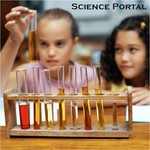
Unit 2 Assignments
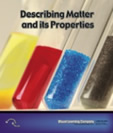
Matter
MS-PS1-1
Heat
MS-PS1-4, MS-PS3-3, MS-PS3-4
Water Cycle
MS-ESS2-4
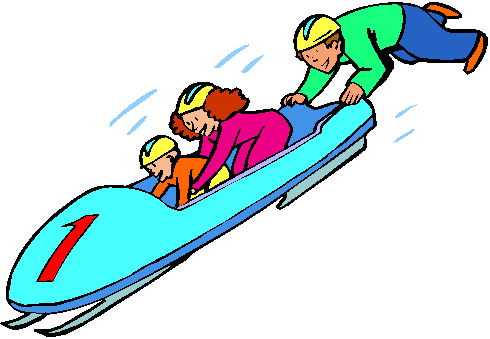
Friction & Gravity
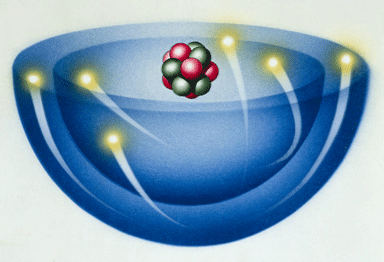
Atoms & Elements

Pressure
 |
Unit 2 Assignments |
 Matter MS-PS1-1 |
Heat MS-PS1-4, MS-PS3-3, MS-PS3-4 |
Water Cycle MS-ESS2-4 |
|
Gap Lessons --> |
 Friction & Gravity |
 Atoms & Elements |
 Pressure |
|
Weather |
| Bundle 2 How does a change in thermal energy affect matter? |
| MS-ESS2-5.
Evidence Statement Collect data to provide evidence for how the motions and complex interactions of air masses result in changes in weather conditions. Packet [Clarification Statement: Emphasis is on how air masses flow from regions of high pressure to low pressure, causing weather (defined by temperature, pressure, humidity, precipitation, and wind) at a fixed location to change over time, and how sudden changes in weather can result when different air masses collide. Emphasis is on how weather can be predicted within probabilistic ranges. Examples of data can be provided to students (such as weather maps, diagrams, and visualizations) or obtained through laboratory experiments (such as with condensation).] [Assessment Boundary: Assessment does not include recalling the names of cloud types or weather symbols used on weather maps or the reported diagrams from weather stations.] |
| MS-ESS2-6.
Evidence Statement Develop and use a model to describe how unequal heating and rotation of the Earth cause patterns of atmospheric and oceanic circulation that determine global climates. Packet [Clarification Statement: Emphasis is on how patterns vary by latitude, altitude, and geographic land distribution. Emphasis of atmospheric circulation is on the sunlight-driven latitudinal banding, the Coriolis effect, and resulting prevailing winds; emphasis of ocean circulation is on the transfer of heat by the global ocean convection cycle, which is constrained by the Coriolis effect and the outlines of continents. Examples of models can be diagrams, maps and globes, or digital representations.] [Assessment Boundary: Assessment does not include the dynamics of the Coriolis effect.] |
| These concepts of energy transfer connect to the idea
that the ocean exerts a major influence on weather and climate by
absorbing energy from the sun, releasing it over time, and globally
redistributing it through ocean currents (ESS2.D as in MS-ESS2-6), which
in turn connects to the idea that global movements of water and its
changes in form are propelled by sunlight and gravity (ESS2.C as in
MS-ESS2-4). These concepts also connect to the idea that complex patterns
of the changes and the movement of water in the atmosphere, determined by
winds, landforms, and ocean temperatures and currents, are major
determinants of local weather patterns (ESS2.C as in MS-ESS2-5). The idea that the iterative process of testing the most promising solutions and modifying what is proposed on the basis of the test results leads to greater refinement and ultimately to an optimal solution (ETS1.C as in MS-ETS1-4) could connect to several concepts, such as energy is spontaneously transferred out of hotter regions or objects and into colder ones (PS3.A as in MS-PS3-3) and weather and climate are influenced by interactions involving sunlight, the ocean, the atmosphere, ice, landforms, and living things, and these interactions vary with latitude, altitude, and local and regional geography (ESS2.D as in MS-ESS26). These connections could be made through tasks such as designing a solar cooker or a device designed for a specific location and is used to harness energy for conversion to practical energy for human consumption such as electricity. For example, a wind-powered electrical generator would be effective and practical in some locations but not in others. In both tasks, students need an opportunity to test solutions to identify the most promising and then modify those to optimize their solutions. |
 How does pressure work? How does pressure work? (Mastery) |
 How does pressure effect me? How does pressure effect me? (Interpersonal) |
 What types of pressures are there? What types of pressures are there?(Understanding) |
 How is pressure different in different things? How is pressure different in different things?(Self Expressive) |
|
Weather Practice Quiz & Espanol Vocabulary Review Activities BrainPop Animations and Practice Quizes |
Vocabulary Winds: Chapter 2 Section 3: Pages 52-60 Air Masses & Fronts: Chapter 3 Section 1: Pages 76-82 Currents & Climate: Chapter 4 Section 4: Pages 134-140: Predicting Weather: Chapter 3 Section 3: Pages 99-109 What Causes Climate?: Chapter 4 Section 1: Pages 112-119 Weather Text - All & Espanol Science Skills Handbook Appendix: Pages 202-214: Process Skills Packet |
| Labs & Videos |
| EngageEngage Discrepant Event |
Explore Research |
Explain Write-Up |
Elaborate New situations/applications |
Evaluate project to share |
| Reading & Math Work |
|
|
| Projects by Learning Style and Media Type |
 Sensing-Thinking
(Mastery) Sensing-Thinking
(Mastery)Facts
|
 Sensing-Feeling
(Interpersonal) Sensing-Feeling
(Interpersonal)A time when you...
|
 Intuitive-Thinking
(Understanding) Intuitive-Thinking
(Understanding)Playing with facts
|
 Intuitive-Feeling
(Self-Expressive) Intuitive-Feeling
(Self-Expressive)Creating new possibiliteis
|
|
|
|
 Live
Presentation Project Live
Presentation Project
|
| Essential Vocabulary & Concepts |
| Picture | Core Knowledge or
Concept |
 |
Density is the amount of matter in a given space. The property of an object to rise or sink is called buoyancy. Water density depends on temperature and salinity (saltiness.) |
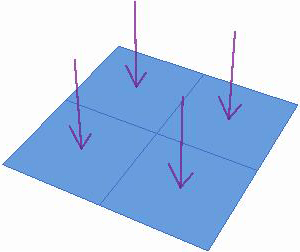 |
Pressure
is a force spread over an area. Pressure (air or water) increases with depth because of the weight of the fluid above. Pressure decreases at higher elevations or altitudes |
| Pressure
in fluids (gasses and liquids) are transmitted
or distributed in all
directions. Wind is created by air moving from an area of high pressure to an area of low pressure. Local Winds are created by the unequal heating of Earth's surface. Global Winds are caused by the movement of air between the equator and Earth's poles |
|
|
|
Coriolis effect-
The effect of the Earth's rotation on the direction of winds and currents. Northern hemisphere - tend to curve right, Southern Hemisphere - tend to curve left. |
| |
Jet Streams Bands of high speed winds 10 kilometers above Earth's surface. They blow from west to east at between 200 and 400 kilometers per hour. |
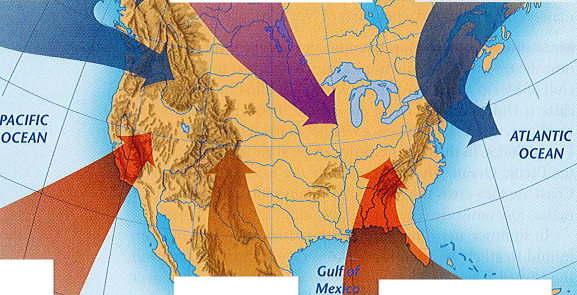 |
Air
Mass A huge body of air that has similar temperature, humidity, and
air pressure. Tropical, Polar, Maritime, Continental In the U.S., Colder, drier polar air masses move south from Canada. Warmer, more humid air masses move north from the Caribean. |
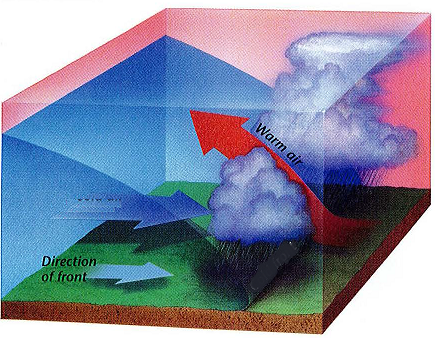 |
Fronts
- The area where air masses meet and interact. Cold, Warm, Stationary, Occluded Cold, dry air tends to sink and warm, moist air tends to rise up, over. |
|
|
Currents
- A large stream of moving water that flows through the oceans Surface Currents are driven mainly by winds. Deep Currents are caused by differences in water density. Colder, more saline (salty) water follows the hills and valleys of the ocean floor. |
|
|
El Ni�o A change in winds and currents in the Pacific
that changes the weather for the American continents. |
|
|
|
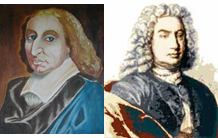 .jpg/220px-Archimedes_(Idealportrait).jpg) |
Scientists Blaise Pascal,,(1623-1662) French mathemetician and religious philosopher whose interest in the mercury barometer led him to climb mountains and experiment with pressure. He invented mechanical adding machines that predicted computers. Daniel Bernoulli (1700-1782) Swiss mathematician whosework with moving fluids is the basis of today's work with airplanes, submarines, water systems, and hydraulics. Archimedes (287-212 BCE) Greek philosopher and mathematician. Supposed to have jumped out of his bath and ran down the streets when he discovered his famous principle of displaced fluids and buoyancy. |
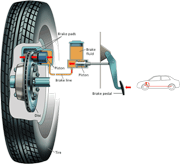 |
Technology Hydraulic and pneumatic brakes in bicycles, motorcycles, cars, and trucks. |